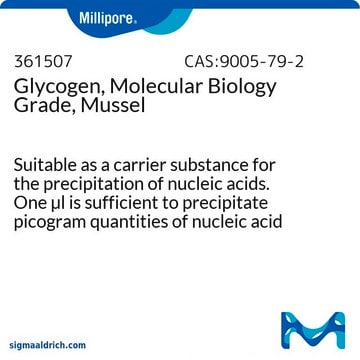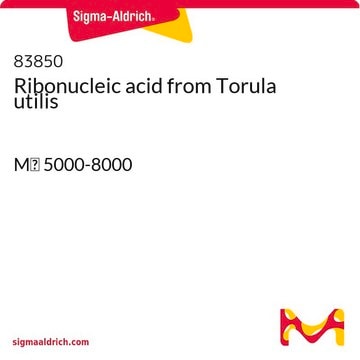10901393001
Roche
Glycogen
from mussels
Synonym(s):
Glycogen, glycogen
Sign Into View Organizational & Contract Pricing
All Photos(1)
About This Item
UNSPSC Code:
41116100
Recommended Products
Quality Level
form
solution
packaging
pkg of 1 mL (20 mg)
manufacturer/tradename
Roche
storage temp.
−20°C
Application
This preparation is used as a carrier for the precipitation of nucleic acids (DNA or RNA). As an inert material it may replace tRNAs or sonicated DNAs.
20 μg glycogen (1 μl solution) allow to precipitate pg-amounts of DNA or RNA from a volume of 1 ml.
In a typical experiment 5 pg [3H]-labeled calf thymus DNA were dissolved in 500 μl 10 mM Tris-HCl, pH 8.0; 1 mM EDTA; 0.4 M LiCl. 1μl glycogen solution (20 μg glycogen) as carrier was added and then precipitated with 1.2 ml ethanol at -15 to -25 °C and stored for 3 hours at -15 to -25 °C. After centrifugation (10 minutes at 12 000 × g) the total radioactivity was found in the precipitate. Without addition of glycogen no precipitation of DNA occured.
20 μg glycogen (1 μl solution) allow to precipitate pg-amounts of DNA or RNA from a volume of 1 ml.
In a typical experiment 5 pg [3H]-labeled calf thymus DNA were dissolved in 500 μl 10 mM Tris-HCl, pH 8.0; 1 mM EDTA; 0.4 M LiCl. 1μl glycogen solution (20 μg glycogen) as carrier was added and then precipitated with 1.2 ml ethanol at -15 to -25 °C and stored for 3 hours at -15 to -25 °C. After centrifugation (10 minutes at 12 000 × g) the total radioactivity was found in the precipitate. Without addition of glycogen no precipitation of DNA occured.
Features and Benefits
Glycogen, in special quality for molecular biology, is an inert carrier in nucleic acid preparations.
Contents
Aqueous solution, 20 mg/ml
Contents
Aqueous solution, 20 mg/ml
Quality
Tested for absence of endonucleases, nicking activity, exonucleases, RNases, nucleic acids, and proteases according to the current Quality Control procedures.
Other Notes
For life science research only. Not for use in diagnostic procedures.
also commonly purchased with this product
Storage Class Code
12 - Non Combustible Liquids
WGK
nwg
Flash Point(F)
does not flash
Flash Point(C)
does not flash
Certificates of Analysis (COA)
Search for Certificates of Analysis (COA) by entering the products Lot/Batch Number. Lot and Batch Numbers can be found on a product’s label following the words ‘Lot’ or ‘Batch’.
Already Own This Product?
Find documentation for the products that you have recently purchased in the Document Library.
Customers Also Viewed
Hanwen Gu et al.
Poultry science, 100(9), 101321-101321 (2021-07-24)
Deep sequencing of RNAs has greatly aided the study of the transcriptome, enabling comprehensive gene expression profiling and the identification of novel transcripts. While messenger RNAs (mRNAs) are of the greatest interest in gene expression studies as they encode for
Ming Wang et al.
Aging cell, 19(6), e13147-e13147 (2020-05-01)
Progerin accumulation disrupts nuclear lamina integrity and causes nuclear structure abnormalities, leading to premature aging, that is, Hutchinson-Gilford progeria syndrome (HGPS). The roles of nuclear subcompartments, such as PML nuclear bodies (PML NBs), in HGPS pathogenesis, are unclear. Here, we
Drew Weissman et al.
Methods in molecular biology (Clifton, N.J.), 969, 43-54 (2013-01-09)
In vitro transcription of DNA with phage RNA polymerases is currently the most efficient method to produce long sequence-specific RNA. While the reaction can yield large quantities of RNA, it contains impurities due to various unwanted activities of the polymerases.
Yunbo Qiao et al.
Nature communications, 11(1), 2653-2653 (2020-05-29)
The transcriptome of the preimplantation mouse embryo has been previously annotated by short-read sequencing, with limited coverage and accuracy. Here we utilize a low-cell number transcriptome based on the Smart-seq2 method to perform long-read sequencing. Our analysis describes additional novel
Gabriele Girelli et al.
Nature biotechnology, 38(10), 1184-1193 (2020-05-27)
With the exception of lamina-associated domains, the radial organization of chromatin in mammalian cells remains largely unexplored. Here we describe genomic loci positioning by sequencing (GPSeq), a genome-wide method for inferring distances to the nuclear lamina all along the nuclear
Our team of scientists has experience in all areas of research including Life Science, Material Science, Chemical Synthesis, Chromatography, Analytical and many others.
Contact Technical Service












